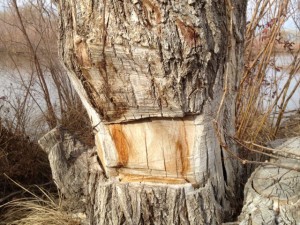I’m going to make up a story. I’d like to think it might be true.
There’s an impromptu path I like to walk along the Rio Grande in Albuquerque that follows a narrow high spot of riverbank for something between a quarter and a half a mile. As you head north, the river’s on your left and to your right is a created marshland, part of an artificial cattail marsh (an ecologist I know who works on the project calls it a “wet meadow”) created as part of a local-state-federal habitat restoration project. It’s great for birding – a golden eagle to my left this morning, serene in a cottonwood across the river, and a riot of birds in the wet meadow to my right – downy woodpeckers, hermit thrush, flickers. In summer it’s a red-winged blackbird metropolis.
All along the path are old dead trees like this one, city garden invaders squeezing out the native cottonwoods, stealing their water (I think this is an elm?) killed by girdling them near their base. Some have been cut down outright, the logs left behind. But many have simply been killed and left standing.
I’ve no idea who did it. It doesn’t bear the hallmarks of the government-funded habitat restoration work that has been done throughout this reach of the river. The restoration crews chip the wood and spread the chips out across the bosque floor. It’s also obviously not the beavers (though there are a lot of small stumps left by beavers, and clear signs that the beavers had been moving back and forth between the river and the wet meadow within hours of my arrival this morning). There are clear saw marks.
I like to think it’s vigilantes, desperately trying to push back against the Anthropocene.

